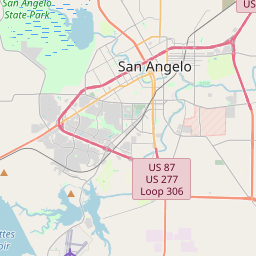Schwartz & Raas and San Angelo National Bank Building
Historical marker location:






These three Victorian commercial structures were built during the local economic boom of the 1880s. Among the earliest permanent buildings in San Angelo, they represent the early development of the city as the leading commercial center of the area.
In 1884 the San Angelo National Bank purchased an existing building in the middle of the block. A new facade was added, under the supervision of contractor J. C. Lillis, which features sandstone from two local quarries and an ornate cornice and pediment. After the bank moved to a new site in 1902, the building housed a variety of businesses.
In 1885 Louis Schwartz and Joseph Raas, owners of a grocery in this block, built a commercial structure adjacent to the bank building. Designed by the noted San Angelo architect Oscar Ruffini, it features a facade of stone, cast iron, and sheet iron. The building was first rented to the firm of Johnson & Taylor, Fancy Grocers, competitors of Schwartz & Raas.
The third structure here, built in 1886, replaced the earlier Schwartz and Raas grocery and dry goods store. In 1888 the business was expanded to include their adjacent building. Later the site of the Roxy Theatre, the 1886 structure was damaged by fire in 1973.
Recorded Texas Historic Landmark - 1981
As one of the most visible programs of the Texas Historical Commission (THC), historical markers commemorate diverse topics in Texas history, including: the history and architecture of houses, commercial and public buildings, religious congregations, and military sites; events that changed the course of local and state history; and individuals who have made lasting contributions to the state, community organizations, and businesses.
The state of Texas was once an independent country known as the Republic of Texas. It gained independence from Mexico in 1836 and was a separate nation until it was annexed by the United States in 1845.
In the late 1800s, the county began to attract settlers looking for opportunities in ranching and agriculture. This period saw an influx of farmers and ranchers who developed the land for cattle and sheep grazing, as well as growing crops such as cotton, corn, and wheat. The population increased significantly during this time, leading to the official organization of Tom Green County in 1874.
The county experienced rapid growth during the late 19th century, thanks to the establishment of Fort Concho and the expansion of the railroad. Fort Concho served as a primary military post protecting settlements against Native American raids and fostered economic growth by providing stability and resources to the region. Additionally, the arrival of the railroad in the 1880s further spurred economic development, making transportation of goods easier and stimulating trade.
In the early 20th century, Tom Green County faced several challenges, including droughts and the Great Depression. However, the county managed to overcome these obstacles and continued to thrive. Today, Tom Green County is known for its agriculture, oil and gas production, and as a center for healthcare and education. With a rich history that encompasses Native American heritage, frontier life, military significance, and economic growth, Tom Green County has played a vital role in the development of West Texas.
Tom Green County Timeline
This timeline provides a condensed summary of the historical journey of Tom Green County, Texas.
- 1874 - Tom Green County is organized and named after Confederate General Thomas Green.
- 1882 - The first courthouse in Tom Green County is built in the city of Ben Ficklin.
- 1884 - San Angelo becomes the county seat after a contentious election.
- 1886 - The Texas and Pacific Railway line is extended to San Angelo, boosting the city's economy.
- 1899 - San Angelo is incorporated as a city.
- 1928 - Goodfellow Air Force Base is established as a training facility during World War II.
- 1952 - Construction of the O.H. Ivie Reservoir begins on the Colorado River near San Angelo.
- 1995 - The San Angelo Museum of Fine Arts opens.
- 2002 - San Angelo experiences a devastating flood, causing significant damage to the city.
- 2015 - The San Angelo Stock Show and Rodeo celebrates its 83rd anniversary.